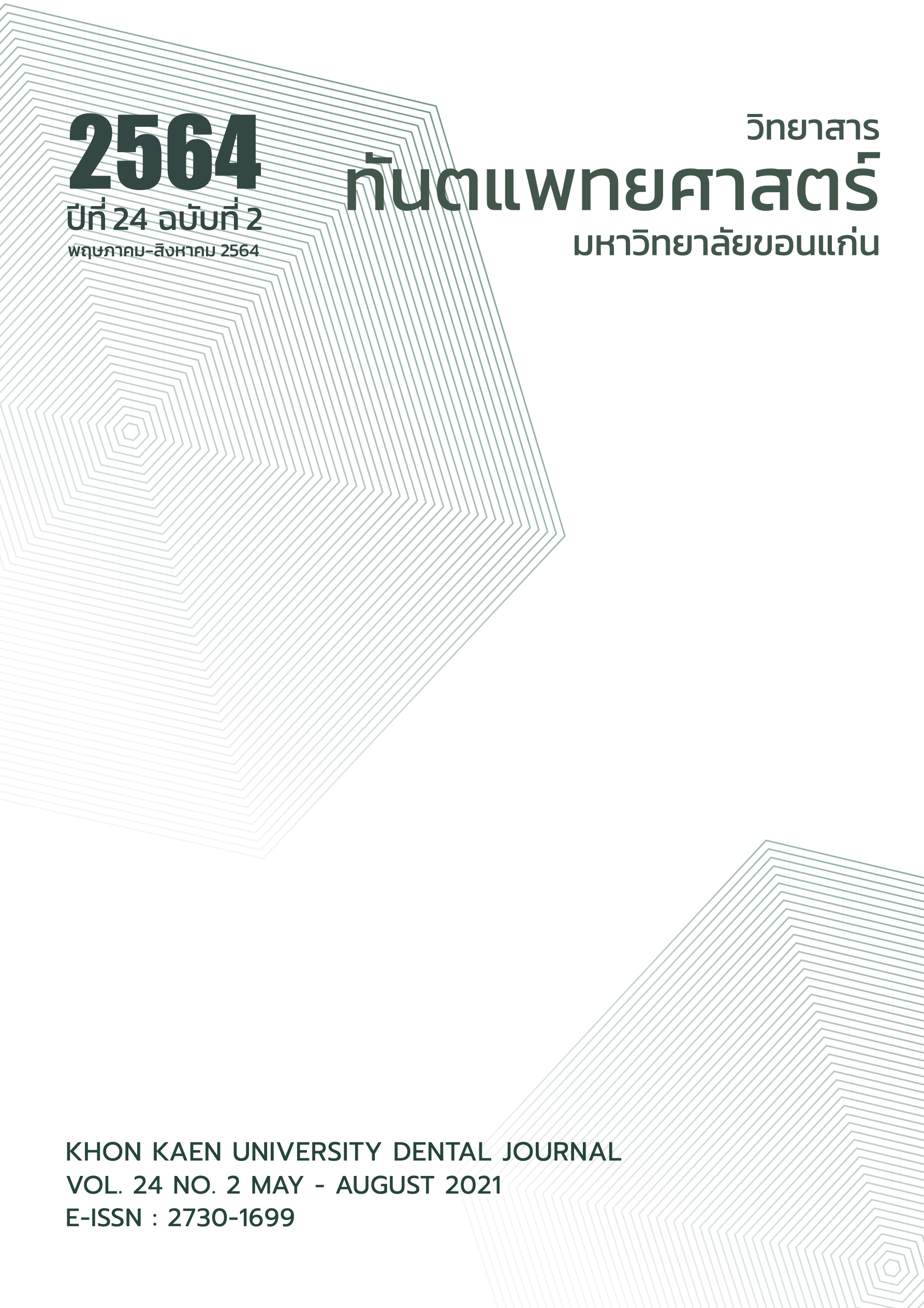Parents' Willingness to Invest for Children’s Oral Health
Main Article Content
Abstract
Willingness to invest (WTI), has been used for cost benefit analysis. WTI is used to assess the consumers’ preference in health measures with considering their ability to pay. This cross-sectional analytical study aimed to compare parents and children’s related factors, caries experiences and WTI of parents for children’s oral health. The study was conducted in 174 pairs of parents/caregivers and 3-9 years-old child, in Faculty of Dentistry, Chiang Mai University. After giving the hypothetical scenario, which was after their children had complete treatment and without active caries, parents/caregivers were interviewed for WTI by using questionnaire. WTI were measured as 1) the number visits of annual dental checkup, 2) the amount of money that parents would pay for a dental visit, and 3) the amount of time that parents would spend daily for brushing their child’s teeth. There was 85.1% of parents/caregivers who would bring their child for annual dental checkup and the 51.2% and 20.7% of them would do every 6 and 3 months. Parents/caregivers would pay 1,044.56 ± 811.10 Baht/visit and would spend 8.85 ± 7.79 minutes/day for brushing. In term of money, there was no difference between parents’ or children’s related factors and WTI. High income’s parents would spend more times for brushing their child’s teeth than whom had low income, with statistically significant. Parents’ value in child dental health can be presented as WTI. Beside of fee for services, there are barriers and hidden cost in each dental visit. WTI should be considered for the payment method and access to oral health care.
Article Details
บทความ ข้อมูล เนื้อหา รูปภาพ ฯลฯ ที่ได้รับการลงตีพิมพ์ในวิทยาสารทันตแพทยศาสตร์ มหาวิทยาลัยขอนแก่นถือเป็นลิขสิทธิ์เฉพาะของคณะทันตแพทยศาสตร์ มหาวิทยาลัยขอนแก่น หากบุคคลหรือหน่วยงานใดต้องการนำทั้งหมดหรือส่วนหนึ่งส่วนใดไปเผยแพร่ต่อหรือเพื่อกระทำการใด ๆ จะต้องได้รับอนุญาตเป็นลายลักษณ์อักษร จากคณะทันตแพทยศาสตร์ มหาวิทยาลัยขอนแก่นก่อนเท่านั้น
References
Permsuwan A. Health Economic Evaluation and Budget Impact Analysis. 1st ed. Chiang Mai: Office of Research Administration of Chiang Mai University;2018.125-9.
Bureau of Dental Health. The 8th Thailand National Oral Health Survey Report. Bangkok: Sam Chareon Panich; 2017;39-41
Casamassimo PS, Thikkurissy S, Edelstein BL, Maiorini E. Beyond the dmft: The Human and Economic Cost of Early Childhood Caries. J Am Dent Assoc 2009;140:650-7.
Hooley M, Skouteris H, Boganin C, Satur J, Kilpatrick N. Parental influence and the development of dental caries in children aged 0-6 years: a systematic review of the literature. J Dent 2012; 40(11):873-85.
Mubaraki S, Abubotain S, AlDhahri S, AlGhamdi R, AlOtaibi R, Pani S. Willingness of Parents to Pay for Space Maintainer Therapy for their Children. Adv Dent Oral Heal 2017;5(3):3-6.
Tianviwat S, Chongsuvivatwong V, Birch S. Different dental care setting: does income matter? Health Econ 2008 Jan;17(1):109-18.
Tianviwat S, Chongsuvivatwong V, Birch S. Prevention versus cure: Measuring parental preferences for sealants and fillings as treatments for childhood caries in Southern Thailand. Health Policy (New York) 2008;86(1):64-71.
Vermaire JH, van Exel NJA, van Loveren C, Brouwer WBF. Putting your money where your mouth is: Parents’ valuation of good oral health of their children. Soc Sci Med 2012;75(12):2200-6.
Berendsen J, Bonifacio C, van Gemert-Schriks M, van Loveren C, Verrips E, Duijster D. Parents’ willingness to invest in their children’s oral health. J Public Health Dent 2018;78(1):69-77.
Van Helvoort-Postulart D, Dirksen CD, Kessels AGH, Van Engelshoven JMA, Myriam Hunink MG. A comparison between willingness to pay and willingness to give up time. Eur J Health Econ 2009;10(1):81-91.
Wang K, Wu J, Wang R, Yang Y, Chen R, Maddock JE, et al. Analysis of residents’ willingness to pay to reduce air pollution to improve children’s health in community and hospital settings in Shanghai, China. Sci Total Environ 2015;533:283-9.
Frew EJ, Wolstenholme JL, Whynes DK. Comparing willingness-to-pay: Bidding game format versus open-ended and payment scale formats. Health Policy 2004;68(3):289-98.
Ethier MC, Regier DA, Tomlinson D, Judd P, Doyle J, Gassas A, et al. Perspectives toward oral mucositis prevention from parents and health care professionals in pediatric cancer. Support Care Cancer 2012;20(8):1771-7
Pitipat W. Research methodology in dentistry. 1st ed. Khon kaen: Khon kaen University Press;2011.168-9.
World Health Organization. Oral Health Surveys: Basic Methods. 5th ed. Geneva: World Health Organization; 2013.42-47.
American Academy of Pediatric Dentistry. Policy on the dental home. Pediatr Dent 2018;40(6):29-30.
Definition of Dental Home. The reference manual of pediatric dentistry. 2018 [cited 2020 Feb 20]. Available from:https://www.aapd.org/media/Policies_Guidelines/D_DentalHome.pdf
American Academy of Pediatric Dentistry. Periodicity of examination, preventive dental services, anticipatory guidance/counseling, and oral treatment for infant children and adolescents. Pediatr Dent 2018;40(6):194-204.
Notification of the Ministry of Health on Health Service Rates in Service Units of the Ministry of Public Health B.E 2562 (A.D. 2019) (2019, August 30) Royal Thai Government Gazette. No. 136
Huebner CE, Riedy CA. Behavioral determinants of brushing young children’s teeth: Implications for anticipatory guidance. Pediatr Dent 2010;32(1):48-55.
De Jong-Lenters M, L’Hoir M, Polak E, Duijster D. Promoting parenting strategies to improve tooth brushing in children: Design of a non-randomised cluster-controlled trial. BMC Oral Health. 2019;19(1):1-12.


